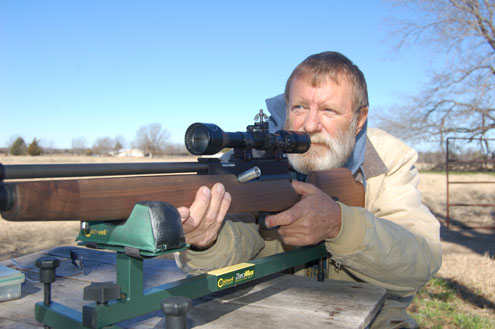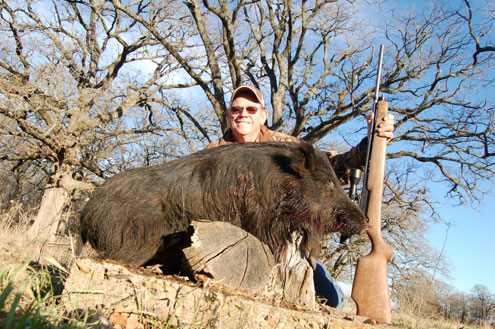Terry Tate’s love of shooting and hunting hogs with his custom made big-bore air rifles is contagious. I first met Terry in Waco about this time last year at Scurry’s Predator and Wild Hog Expo. As is common with hog hunters, the conversation quickly turned to our preferred methods of killing hogs. Terry showed me some pictures of his big-bore hog killers and I was amazed at how compressed air could possibly generate enough energy to cleanly kill a big boar, or even a 125-pound meat hog for that matter. My introduction into airgunning for hogs began right then and there.
For the past few months, I’ve done a good bit of study on the history of air rifles and was amazed to learn that the success of the Lewis and Clark Expedition hinged heavily on a single air rifle that the party carried. Upon entering each Indian village, Lewis would break out his cherished .46 caliber Girandoni rifle, designed by an Italian and manufactured for use by the Austrian Army in the latter part of the 19th Century, and give the Indians a shooting demonstration. This silent, deadly accurate rife that fired 40 times without an appreciable lose of velocity impressed the Native American tribes so much that the expedition had little resistance.

Before joining Tate for a morning of shooting, including using his .45 caliber air rifles, I was convinced that compressed air could send a projectile fast and far enough to cleanly kill big game but still, in the back of my mind, I remembered those little pump up .177 caliber rifles that I used to hunt squirrels and rabbits with as a boy. I must admit there was a shadow of doubt as to what these larger versions of my little squirrel rifle could do on a big boar with thick hide, large bones and a protective shield that covered his vitals.
My doubts ended with the rifle’s report from my first shot. Tate had some targets set up about 75 yards out from a shooting bench. Using a fiber carbon tank, he showed me how to “charge” the rifle with 3,500 psi of compressed air.
I let the crosshairs settle on the bull's eye and took the little bit of slack out of the trigger then, all I heard was a very subdued but obviously powerful crack. The target was tacked to a piece of half inch plywood and the bullet blew through the wood as though it was paper. There was little doubt by the sound and the flying pieces of wood that this big heavy bullet was traveling fast. Neither was there any doubt as to the damage it inflicts on wood or, muscle and bone upon arriving at its destination. My first 3-shot group measured just over 3 inches and I later watched Tate place 3 rounds that almost touched.
After the morning training/shooting session, my confidence level in air rifles as hog killers had increased but I must admit, I still had my doubts as to the effects the big bore air powered rifle would do on a big, nasty boar. Later that day, I had the opportunity to find out!
Tate’s plan was for us to put a mid day sneak on a corn feeder set to throw corn at noon. As we walked to the remote creek bottom, Tate explained how he hoped the hunt to unfold.
“These hogs get almost no hunting pressure," Tate said. "I take one for meat occasionally but make it a point not to pressure them too much. We will probably find hogs hitting the feeder situated between the creek and a big cane break but with this north wind, we might spook them. If we approach from directly downwind, we will have to cross the trail they use coming to the feeder which will spook approaching hogs. Let’s try quartering into the wind and hope for the best. If we spook them, we should be able to make a big circle and still hunt into the wind.”
Tate led the way and as we got close to the area he expected to hold hogs, I got directly behind him in efforts to remain concealed. We heard the sounder of hogs before we saw them. They were four or five right under the feeder and more, as Tate had predicted, coming from the creek directly down wind.
Cane breaks are by nature some of the heaviest cover in the woods and as we needled our way through a mass of pencil thick switch cane, I eased my Zeiss Terra ED binoculars through a tiny opening. There were a couple of 125-pound sows and two of their smaller pigs at the feeder; coming from the creek was a big boar. Tate and I later guessed his weight at a conservative 275 pounds.
A mature boar is beyond doubt one of the smartest critters in the woods, in my humble opinion, the smartest. Before closing the distance to the feeder, I watched the hog put its snout into the air and suck in air. His refined olfactory system was dissecting the air particles with precision gleaned over eons of swine evolution. His head went down and he spun 180 degrees in his tracks. His trained nose had detected us. Then he was gone, the smaller sows and pigs bouncing through the creek bottom behind him.
“It’s time for our back up plan,” whispers Tate. “Let’s take a walk and get downwind of the hogs. We only saw a fraction of them at the feeder. They stage during mid day in the cane growing along the creek. The next time we encounter hogs, we will likely be right on top of them.“
Tate was toting one of his custom .45 caliber big bores as a back up. Stalking hogs in tight cover has the potential to get exciting. Hogs can run as fast as a race horse for a short distance and in this thick stuff we soon discovered just how fast a startled hog can move!
As we rounded a bend of the creek, the smell of wild hogs was heavy in the cold air. We moved as quietly as possible and then, with absolutely no warning other than their smell, a couple of big hogs bounded out of the cane, one of them was coming right for me. Good pictures are always important to me and I had stopped to shoot some images of the creek bottom. The click of the camera might have been what spooked the hogs; they use their ears almost as well as their nose to detect danger.
I stepped behind a big pin oak as the runaway boar dashed by at about 5 feet, exactly where I had been standing. Whether he was charging or not, I do not know but had Tate and I remained in the open, it’s a good chance we would have run us over. Thank goodness for a big tree when one is really needed!
Farther down the creek, we came upon an undisturbed boar that weighed about 150 pounds. One shot from the big bore air rifle proved what I expected; when a master gun builder works his magic with wood, steel and O rings, compressed air is a very effective propellant for big, heavy lead bullet. More pork for my freezer. I absolutely love hunting wild hogs!

Listen to Outdoors with Luke Clayton radio at www.catfishradio.com. Join Luke and his guests Larry Weishuhn and Bill Dance each week for some exciting outdoor talk. Email Luke via the web site with outdoor news from your area.